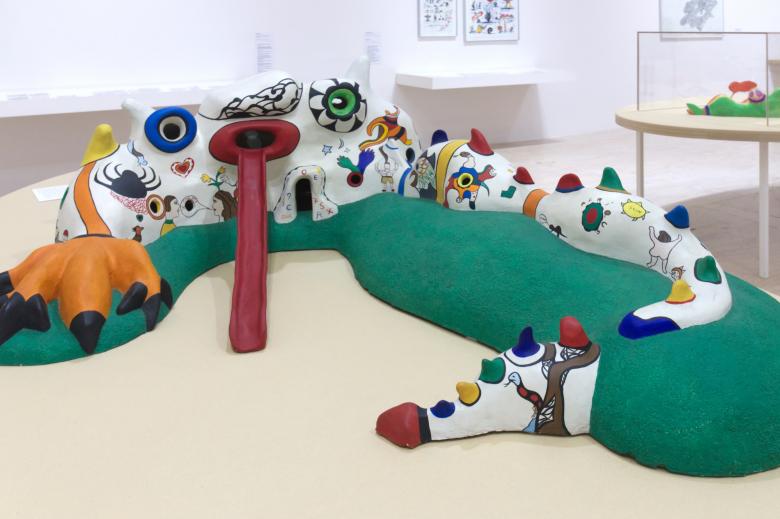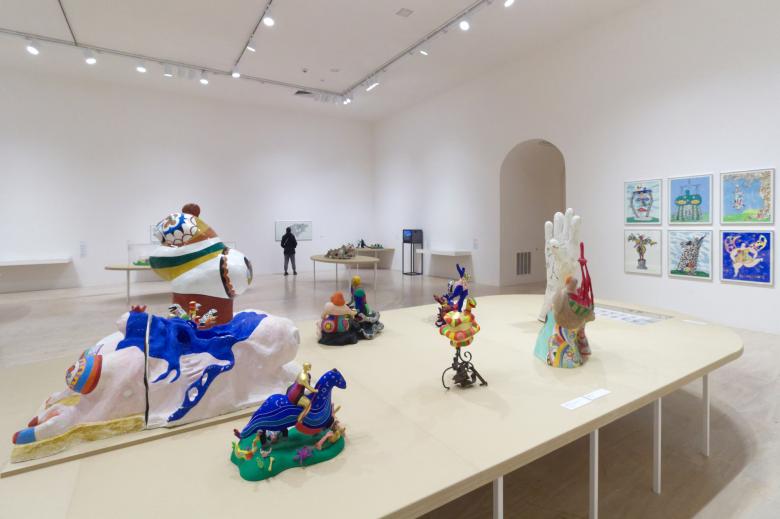Niki de Saint Phalle's 'Architectures for Children'
Niki de Saint Phalle: Museum Boijmans-Van Beuningen, Rotterdam, 22 juli-5 september, 1976. (Photo: John Hill/World-Architects)
Niki de Saint Phalle: Structures for Life is a major exhibition at MoMA PS1 in New York City devoted to the self-taught French-American artist known for playful figural sculptures, the large Tarot Garden in Italy, and other architectural works that spark joy, especially in children.
About halfway through the series of third-floor galleries devoted to Structures for Life is an interview with Niki de Saint Phalle (1930–2002) from 1985, in which at one point she talks enthusiastically about a couple sculptures she is building for children. Toward the end of the exhibition — it is in sequential order due to COVID-19 restrictions — is an artist's book published by Museum Boymans-van Beuningen in Rotterdam in 1976 (photo at top), in which she starts: "I want to show you 2 architectures for children." Even though Saint Phalle gained international attention in the 1960s for violent "shooting paintings" that involved rifles and paint, her joyful creations geared toward children come to the fore in the exhibition.
"I wanted to give visitors, especially children, a place of Joy, where they could enjoy art and nature together," Saint Phalle said about Tarot Garden, her magnum opus. Built over the course of two decades, starting in the mid-1970s, and featuring a visitor center designed by Mario Botta, Tarot Garden features 22 large-sculptures representing the Major Arcana from a deck of tarot cards. Some of the figures in this playground of fantasy are so big as to be inhabitable, with Saint Phalle actually living in The Empress, a Sphinx-like structure, for a time. The exhibition devotes some of its space to Tarot Garden, but it draws attention to other lesser known works that also convey the attention Saint Phalle gave to children.
A short tour through some of the exhibition:


The first gallery in the exhibition is the largest, with numerous maquettes and other studies for sculptures and playgrounds on display. (Photo: John Hill/World-Architects)
Maquette pour le Dragon de Knokke, c. 1973. Saint Phalle, working with her second husband, artist Jean Tinguely, built a large iron-and-cement Dragon for the son of Belgian art collectors Roger and Fabienne Nellens. (Photo: John Hill/World-Architects)
L:
Maquette for “Janus Head” playground, Los Angeles, c. 1980. Not all studies became architectural realities, including this slide for a playground in California. Her only US sculpture garden,
Queen Califia's Magical Circle (2003), is located in Escondido, between Los Angeles and San Diego, parts of which resemble the maquette on the right:
Lézard house ou École maternelle, 1974. (Photo: John Hill/World-Architects)
A large table is devoted to maquettes for Tarot Garden, which was built in Capalbio, Tuscany, between 1978 and 1998. (Photo: John Hill/World-Architects)
A wall with collaged lithographs illustrates some of the 22 figures that would populate Tarot Garden. (Photo: John Hill/World-Architects)
The second gallery is a narrow space dominated by Last Night I Had a Dream, 1968–1988. (Photo: John Hill/World-Architects)
As the name indicates, Last Night I Had a Dream, 1968–1988, is the representation of the remembered moments of a dream, with figures both human- and monster-like spread across the wall. (Photo: John Hill/World-Architects)
Another narrow gallery — where La peste, 1986, is found — is devoted to Saint Phalle's efforts in educating schoolchildren in France about the AIDS epidemic, attempting to correct misconceptions spreading at the time. (Photo: John Hill/World-Architects)
Chapelle, 1975. Another gallery is devoted to Saint Phalle's sets for The Traveling Companion, the planned video adaptation of a Hans Christian Andersen fairy tale. The project was shelved in 1977 and one year later Saint Phalle started construction on Tarot Garden, her masterpiece. (Photo: John Hill/World-Architects)









